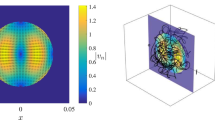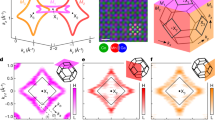Abstract
In 1867, Lord Kelvin proposed that atoms—then considered to be elementary particles—could be described as knotted vortex tubes in either1. For almost two decades, this idea motivated an extensive study of the mathematical properties of knots, and the results obtained at that time by Tait2 remain central to mathematical knot theory3,4. But despite the clear relevance of knots to a large number of physical, chemical and biological systems, the physical properties of knot-like structures have not been much investigated. This is largely due to the absence of a theoretical means for generating stable knots in the nonlinear field equations that can be used to describe such systems. Here we show that knot-like structures can emerge as stable, finite-energy solutions in one such class of equations—local, three-dimensional langrangian field-theory models. Our results point to several experimental and theoretical situations where such structures may be relevant, ranging from defects in liquid crystals and vortices in superfluid helium to the structure-forming role of cosmic strings in the early Universe.
This is a preview of subscription content, access via your institution
Access options
Subscribe to this journal
Receive 51 print issues and online access
$199.00 per year
only $3.90 per issue
Buy this article
- Purchase on Springer Link
- Instant access to full article PDF
Prices may be subject to local taxes which are calculated during checkout
Similar content being viewed by others
References
Thomson, W. H. Trans. R. Soc. Edinb. 25, 217–220 (1869).
Tait, P. G. On Knots I II, III in Scientific Papers Vol I. 273–347 (Cambridge Univ. Press, 1898).
Atiyah, M. The Geometry And Physics of Knots (Cambridge Univ. Press, 1990).
Kauffman, L. H. Knots And Physics (World Scientific, Singapore, 1993).
Green, M. B., Schwarz, J. H. & Witten, E. Superstring Theory Vols I, II (Cambridge Univ. Press, 1987).
Witten, E. Commun. Math. Phys. 121, 351–375 (1989).
Bowick, M. J., Chander, L., Schiff, E. A. & Srivastava, A. M. Science 263, 943–945 (1994).
Bäuerle, C., Bunkov, Yu. M., Fisher, S. N., Godfrin, H. & Pickett, G. R. Nature 382, 332–334 (1996).
Ruutu, V. M. H. et al. Nature 382, 334–336 (1996).
Summers, D. W. Notices of AMS 42, 528–537 (1995).
Rebbi, C. & Soliani, G. Solitons and Particles (World Scientific, Singapore, 1984).
Faddeev, L. D. Takhtajan, L.A. Hamiltonian Methods in the Theory of Solitons (Springer, Berlin, 1987).
Makhankov, V. D., Rybakov, Y. P. & Sanyuk, V. I. The Skyrme Model: Fundamentals, Methods, Applications (Springer, Berlin, 1993).
Faddeev, L. D. Quantiziation of Solitons (Princeton preprint IAS-75-QS70, Institute for Advanced Study, 1970).
Faddeev, L. D. in Relativity, Quanta and Cosmology Vol. I (eds Pantaleo, M. & De Finis, F.) 185–192 (Johnson Reprint, 1979).
Vakulenko, A. F. & Kapitanski, L. V. Dokl. Akad. Nauk USSR 248, 810–814 (1979).
Sewell, G. Adv. Eng. Software 17, 105–112 (1993).
Simon, J. K. J. Knot Theory Raminif 3, 299–320 (1994).
Author information
Authors and Affiliations
Rights and permissions
About this article
Cite this article
Faddeev, L., Niemi, A. Stable knot-like structures in classical field theory. Nature 387, 58–61 (1997). https://doi.org/10.1038/387058a0
Issue Date:
DOI: https://doi.org/10.1038/387058a0
This article is cited by
-
Topological atom optics and beyond with knotted quantum wavefunctions
Communications Physics (2024)
-
Hopfion rings in a cubic chiral magnet
Nature (2023)
-
Topologically crafted spatiotemporal vortices in acoustics
Nature Communications (2023)
-
Magnetic hopfion rings in new era for topology
Nature (2023)
-
Energy spectrum of the ideal DNA knot on a torus
European Biophysics Journal (2023)
Comments
By submitting a comment you agree to abide by our Terms and Community Guidelines. If you find something abusive or that does not comply with our terms or guidelines please flag it as inappropriate.



